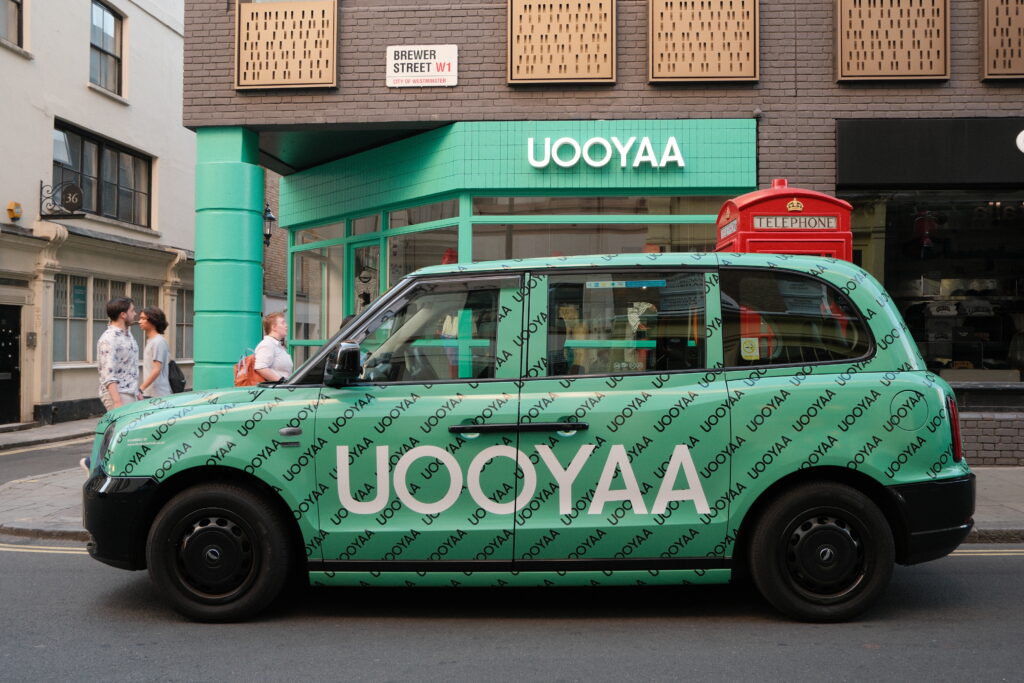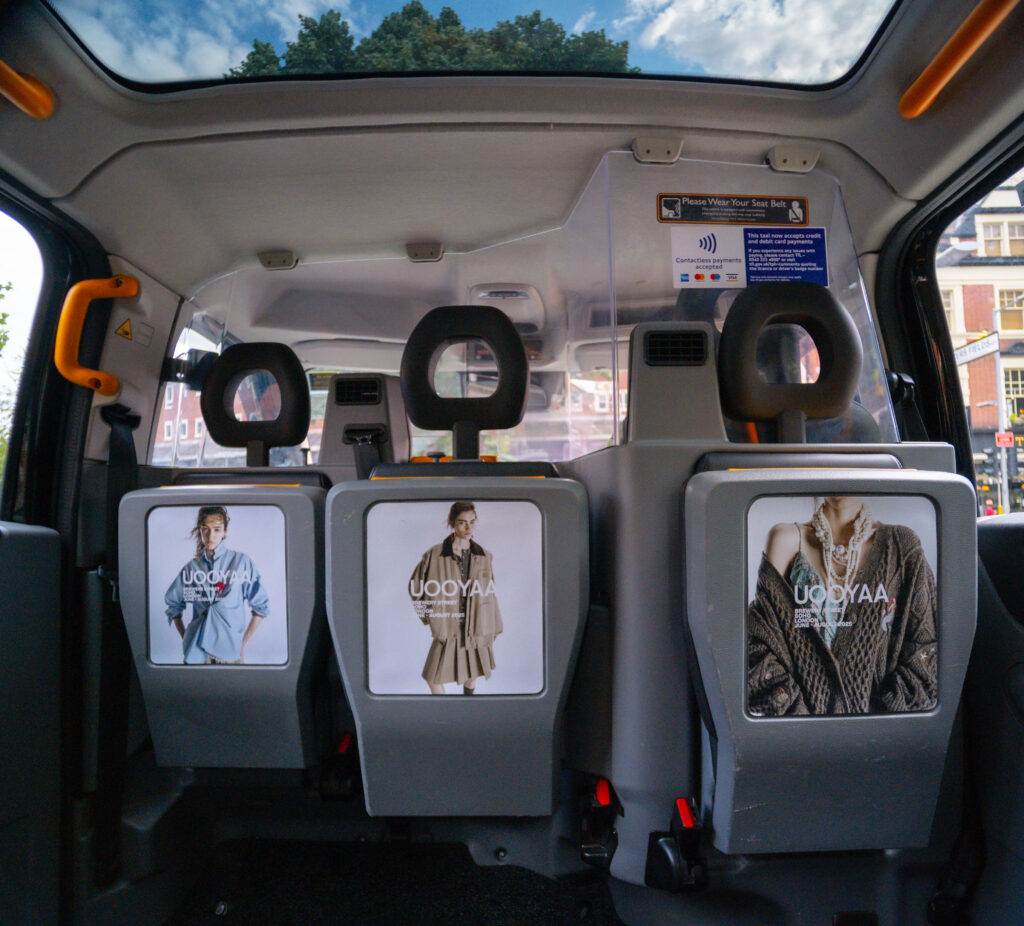Taxi advertising is undergoing a remarkable transformation in 2025. Vinyl wraps on black cabs have evolved into a sophisticated and data-driven marketing channel. The future of taxi advertising trends points toward a dynamic fusion of technology, interactivity, and hyper-personalization, turning every urban journey into a measurable brand experience.
The global in-taxi digital advertising market is experiencing a significant surge, with a projected compound annual growth rate of over 15% through 2033. This growth is fueled by increasing urbanization and the demand for targeted advertising solutions that cut through digital noise.
As urban mobility returns to pre-pandemic levels, brands are rediscovering the power of a captive audience, with the average urban taxi journey lasting approximately 18 minutes. This evolution isn’t just about showing ads; it’s about creating meaningful connections in a world overwhelmed by fleeting digital content.
The Digital Revolution: Interactive Screens and Dynamic Content

The most prominent trend shaping the future is the integration of digital screen technology both inside and on top of taxis. The in-taxi digital advertising market is set to reach nearly $3 billion by 2033.
- In-Cab Digital Displays: Passenger-facing tablets are dominating the market, accounting for a significant portion of revenue due to high engagement rates. These screens offer interactive content, allowing passengers to engage with brands through videos, games, and targeted offers. Video content is particularly effective, generating a substantial share of advertising revenue within this sector.
- Digital Taxi Tops: Following the trend in cities like New York and Dubai, London’s taxi advertising is increasingly adopting digital taxi tops. These LED screens allow for dynamic content that can change based on location, time of day, or even weather conditions. Programmatic advertising now facilitates a majority of these ad placements, improving targeting efficiency.
AI and Data: The Engine of Hyper-Personalization
Artificial intelligence is the driving force behind the next generation of taxi advertising, enabling a level of personalization previously unimaginable in out-of-home (OOH) media.
- Smart Targeting: AI algorithms analyze real-time data to deliver hyper-personalized ad experiences. This includes route information, time of day, and anonymized passenger demographics. AI-optimized campaigns have demonstrated significantly higher engagement rates compared to conventional methods.
- Predictive Analytics: Machine learning models can now forecast campaign performance, recommend optimal fleet sizes, and suggest creative variations before a campaign even launches. This data-driven approach shifts taxi advertising from a brand awareness tool to a performance marketing channel.
- Performance Measurement: Advanced analytics offer precise ROI measurement. GPS tracking provides exact impression counts, while QR codes and unique promo codes attribute sales directly to taxi ad exposure. Location-based targeting alone has been shown to improve conversion rates for retail and hospitality advertisers.
Immersive Experiences: Augmented Reality and Gamification

The future of creative taxi advertising lies in creating immersive and memorable brand interactions that go beyond the screen.
- Augmented Reality (AR): AR is set to transform static ads into interactive adventures. Passengers and pedestrians will be able to use their smartphone cameras to unlock hidden layers of content, participate in gamified scavenger hunts, or experience virtual product try-ons. The implementation of AR in advertising is projected to grow at a remarkable rate annually through 2030.
- Experiential Campaigns: Taxis are becoming mobile pop-up experiences. Brands are converting cabs into mini-showrooms, beauty salons, or product sampling stations. These “brand encounters” generate significant social media buzz and word-of-mouth marketing.
Sustainability: A Core Brand Value
Environmental consciousness is no longer an option but a necessity. The shift toward eco-friendly practices is a defining trend in the future of taxi advertising.
- Electric Vehicle (EV) Fleets: With London aiming for a significant portion of its taxi fleet to be electric by 2030, brands are increasingly aligning with EV taxis to bolster their ESG (Environmental, Social, and Governance) credentials.
- Eco-Friendly Materials: The industry is moving toward recyclable wraps, biodegradable inks, and solar-powered digital displays to reduce the environmental footprint of campaigns. This commitment to sustainability resonates strongly with modern consumers.
The Integration with Smart City Infrastructure

As cities become more connected, taxi advertising will integrate with urban infrastructure to create a seamless advertising ecosystem.
- Connected Transportation Systems: Many European cities are implementing connected transportation systems. This allows taxi ad networks to sync with public transport schedules, traffic management data, and city event calendars for highly targeted and efficient campaigns.
- Multi-Modal Advertising: The future will see consistent brand messaging across various modes of transport, from taxis and ride-hailing services to buses and trains, creating a cohesive brand narrative throughout a consumer’s journey.
A New Horizon for Urban Brand Engagement
The future of taxi advertising is bright, dynamic, and intelligent. The convergence of digital technology, AI-driven data analytics, and creative innovation is transforming a traditional medium into one of the most effective and measurable channels for urban brand engagement. As the global taxi market is projected to grow significantly, the opportunities for advertisers will expand in tandem.
Brands that embrace these trends will not only capture attention but also build meaningful connections with their audience. The taxi of the future is more than just a mode of transport; it’s a mobile, interactive, and highly effective media platform ready to drive brand success on the streets of London and beyond.
FAQs
1. How will technology change taxi advertising?
Digital screens inside and on top of taxis will deliver dynamic, location-based ads. AI will personalize content in real-time based on route and passenger data, while AR will create interactive experiences, boosting engagement significantly.
2. Is taxi advertising becoming more measurable?
Yes. GPS tracking provides precise impression counts, while QR codes and unique promo codes directly link ad exposure to website visits and sales. Advanced analytics now offer ROI measurement comparable to digital advertising platforms.
3. What role does sustainability play in the future of taxi advertising?
It’s crucial. Brands are increasingly using electric taxi fleets and eco-friendly materials like recyclable wraps to align with consumer values and corporate ESG goals. This practice enhances brand perception and public image.
4. How does AI improve taxi advertising campaigns?
AI optimizes ad delivery by analyzing real-time data on location, time, and weather. It enables hyper-targeted messaging for different demographics, leading to higher engagement rates and a better return on investment for advertisers.
5. Will taxi advertising work for smaller businesses in the future?
Absolutely. Programmatic ad buying and flexible digital screen options will make taxi advertising more accessible. Hyper-local targeting will allow small businesses to run cost-effective campaigns in specific neighborhoods, reaching their ideal customers efficiently.
